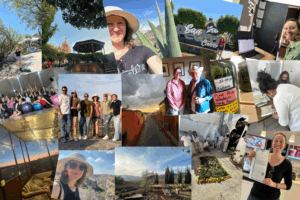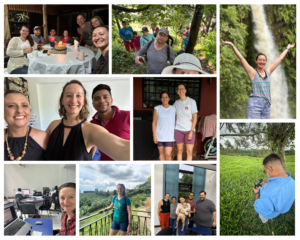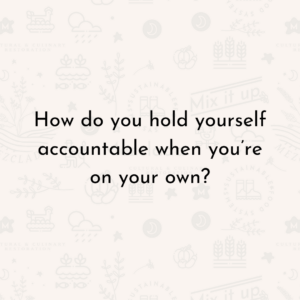Note: This is the first post in a series that’s dedicated to sharing information with farmers and food systems professionals that are working to access capital through grant applications.
As someone who treated writing scholarship essays as a part-time job throughout college to pay for school, and graduated with ZERO student loans, in retrospect I see why grant writing comes so naturally to me.
To be a great writer means to tell a great story.
And to be a great scholarship essay writer – or grant writer – means to very clearly outline what you need money for and how you will use it to serve a cause that’s much greater than your own.
I learned this early on in college, and to be honest, I used each scholarship application as an opportunity to ‘try out’ a different version of what my future could look like, based on what I wrote about in my applications. All of it was valid. As a generalist, a natural learner, and multi-passionate, everything I wrote about were things that I genuinely wanted to do. Only the applications that got funded, however, were the things that I ended up pursuing. I don’t believe in coincidences, so I know that the applications that did get funded were supposed to, and I’ve ended up exactly where I’m supposed to be today.
When we think about what makes for a winning grant application, especially those that are being written by farmers and food systems professionals, step #1 comes in with cultivating the level of discernment that will allow you to focus your energy in a way that gets you the best return on investment.
That is, knowing what questions to ask to decide – Is this grant application worth my time? How likely am I to get it? Am I really the best fit for this funding source?
Most people I know are constantly scanning RFPs (requests for proposals), solicitations for proposals, and new grant applications in their inbox on the daily. But the mindset that they carry into the process is that of ‘what is a good enough fit?”, not ‘what is the right fit’? They may have a general sense of what they need money for, but they’re not laser focused on knowing exactly how much they need for which type of programming, or even how that idea might be sustained in the long-term financially, building into the design elements that will naturally allow for more revenue generation.
We’re currently operated in an unprecedented time of funding that’s being made available at the state and federal level for regional food systems work, and it’s absolutely incredible. But to overcome the overwhelm and frustration, my recommendation is to start by getting laser focused on what you need, by when, and what that will do for your community. Only after doing this, do I recommend taking a look at the following list of questions to help you evaluate whether or not a grant opportunity is the right fit for you or your organization to pursue.
Should I apply for the grant? Key Questions to Ask:
1. What is the scale of the grant?
First question to help you get a sense of the magnitude of time involved is asking yourself at what level is this grant being made available? State grants you should probably, under most estimates, allow anywhere between 30 and 40 hours, depending on which agency/department it’s coming from, and how the grant has been designed. For example, I helped write a grant for non-profit last year with the Department of Human Services that took us 40 hours to write, asking for 300K for three years. There were so many attachments, including letters of support, documentation showing the qualifications of the staff involved, and more.
A federal level grant is likely to take a bit more time, as it’s usually more money and often over longer time-periods. The reporting associated with these grants is very high and should not be overlooked. Most times you are given a cap of about 10%, unless you have some kind of special cooperative agreement with the government, to spend on ‘administrative costs’ which in almost every grant that I’ve worked on, ends up being closer to 15%. It’s a real challenge to flesh out a budget that’s working against the natural ways of work from the start.
2. When is the deadline?
Comparing questions #1 and 2 will give you a very clear sense of feasibility right from the beginning. I like to allow between 4 and 6 weeks for a state or federal grant. Any less than that and you should expect to spend full 8-hour days dedicated to writing, communications, coordination with your project partners, and literally nothing else. Luckily we have some amazing technologies out there that can help make this easier and reduce the workload, which I’ll get to later, but ideally you want to put yourself in a position where you can submit a day or two ahead of schedule to reduce your stress level.
3. Are there matching requirements?
Matching requirements mean that if you want to apply for funds, you also have to put money towards the project, as outlined in your project budget. There are creative ways to work around this, which I’ll be digging into in a future post that talks specifically about differences between in-kind vs. cash matches and how to pull in money through non-monetary means. To apply for a 50K grant at a 50% cash match means you need to have 25K on hand to put towards the project, which is no small amount.
Depending on the matching requirements, this may also be the point where you decide whether or not it’s worth pursuing, because you either have the resources or you don’t.
4. Who are the eligible entities to apply? What is their legal structure?
Most state and federal-level grants will outline specifically what kinds of entities are eligible to apply for funding, whether that’s a non-profit, private business, institution such as a school or local government, or even sometimes a cooperative group of entities can apply under one name/umbrella.
If you aren’t any of the eligible entities, you can consider getting a fiscal host – also something I’ll cover in a future post – which which basically be a business that funnels money through themselves and on to you.
You may also consider partnership opportunities where an entity may serve as the lead applicant on paper, but in actuality you or your organization is the one doing the work on the ground. I’ve had to do this several times as part of a local foods committee made up of many different organization types, ranging from local government to private businesses to nonprofits.
5. What is the funding for exactly?
If you’ve made it to this point and you haven’t ruled out the funding source, that’s great! Now you’ll want to make sure that what you have in mind/what you need funding for is in alignment with what is described in the request for proposals.
I like to think about this in the same way that I do for job applications. If you aren’t ecstatic about writing the cover letter for the position because you feel like it’s been written for you, walk away. It’s not for you. Don’t try to massage your application to try to fit into their box unless you truly have flexibility in how you want things done, on your farm, in the community, or elsewhere. Stay true to your mission and your north star and don’t forget about your WHY.
6. Does the grant operate on a reimbursement basis or do they provide you with the funds up front?
I will say, this is one of the most challenging aspects about evaluating grant applications, because many people don’t realize that frequently at the state and federal level, you need to have cash on hand to even get started. You won’t actually get the funds until you have receipts for what you’ve spent your money on. For cash-strapped individuals and organizations, this can prove to be a huge hurdle, and is something that we’ll cover in a future post.
6. Does the timeline of funding align with when you need it?
Amazing! You’ve identified that the funding source is a good fit AND that you have the funds needed for a match. You’ll want to then look at the timeline and assess whether or not you can work with when the funds are distributed. If you have an urgent need, most times I don’t recommend grant writing at all, as you’re more likely to get a better return on investment just asking for money directly from others. This will, of course, require you to still have a damn good story to tell.
Keep in mind that a deadline is not the day of disbursement (when you get the funds). A deadline is when the portal for applications close.
Then you’ll have a deadline of notifications (finding out if you’ve made it past the first cut or have been selected), a deadline for when contracts need to be put in place/signed, and then a date for when the funds will actually be made available. This can range everywhere from 3 to 6 months! So plan ahead.
7. Do I have the right partners to call on for this application?
The last question I would ask if I were evaluating a grant application is if I have the right partners either in mind or in place to apply for this application. If you’re applying for a research grant related to on-farm production practices, you may be able to get by with just your own entity, no problem. But you might have an application that requires at least two or three farmers to conduct on-farm trials and compare results across different geographies. Or you may need to bring someone else in to serve as a third-party evaluator, who isn’t part of the rest of your team.
This is where relationships, and building/investing in your professional network can reap huge rewards. I know of so many people who will last-minute pull together an application, draft letters of support, and get something out the door in two weeks because they’ve been talking to others about these issues and project ideas for months, if not years.
The seeds for projects are often planted well in advance, which can make the whole grant writing process seem daunting. But rest assured, by taking the time to even look at the list I’ve put together here, you’re already well ahead of many other writers out there. I want to leave you with a few prompts to help stimulate some thinking about projects that you want funded, so that the next time you’re reviewing an opportunity, you’ll already have a reference for what you want.
Journal Prompts for Clarity: What Do I Want To Fund & Why?
- If I had no resource limits, what would I do in the next 12-24 months? With whom?
- What is motivating this? What is my true purpose and what values are guiding this decision?
- What is the potential impact if this were to prove successful? How would I know?
- What are the ways that I’m measuring impact for this particular idea? Is that something that will translate well to others if they were to ask me to share progress on my project idea?
- Would I still do this if I didn’t have the financial resources to do it?
- Who are my cheerleaders? Who would sign a letter of support today without even asking to see my application because they know the quality of my work and my ability to follow through on what I say I will do?
- Where is there opportunity to build relationships where there aren’t any currently? Could I use a funding opportunity as a way to work with someone new or different that may challenge me to think and work differently? What could a mutually beneficial arrangement look like, where EVERYONE wins?
- How do I want to change in the process of this work? What do I need to do to put myself in a position of change as part of this work? How might that show up on the roster of leadership positions for this project? Do I need to step up or step back?
- What would I love to see as a testimonial from someone at the end of this project in what I turn over to the grant funders, if I were to receive this money? How does that illustrate the real impact of this work? What kind of kind hand written note would bring tears to my eyes because of the change that I’ve helped make through this work?
- What’s stopping me from pursuing this now?
AI: The Technology That Might Just Change Your Grant Writing Forever
I cannot help but put in a plug for a workshop that I’ll be offering early in April that walks people through my own process of grant writing in real-time, using a group I’m involved with in West Central Minnesota.
I believe that the power of AI is still untapped, and that for many people who hate writing or are fearful of technology, there is an opportunity to build a healthier relationship with this technology.
I use AI in my work daily, and have saved so many hours of tedious research and writing it’s INSANE. I’m also looking at investing in my learning through a course that blends AI with design tools to help farmers with their marketing and greatly reduce the cost, reaching more customers that are willing to pay more for their products, and therefore creating greater financial sustainability for their operations.
In fact, creating this workshop stems from the same idea – that in sharing my process with you, the inner workings of AI will be demystified, you’ll develop the confidence and possess the knowledge you need to put in an application for that funding source you’ve been eyeing for years.
I’ll be releasing videos that show my process via YouTube, and then for folks that register, you can get access to a Word document that outlines the details in written form. To be among the first who are notified of when this workshop goes live, definitely sign up for Mezclada’s newsletter, as that’s where I’ll be sharing details.
You can also follow along on social – Instagram, LinkedIn, and Facebook, where I’ll be linking more posts like this one so that you don’t miss it!



